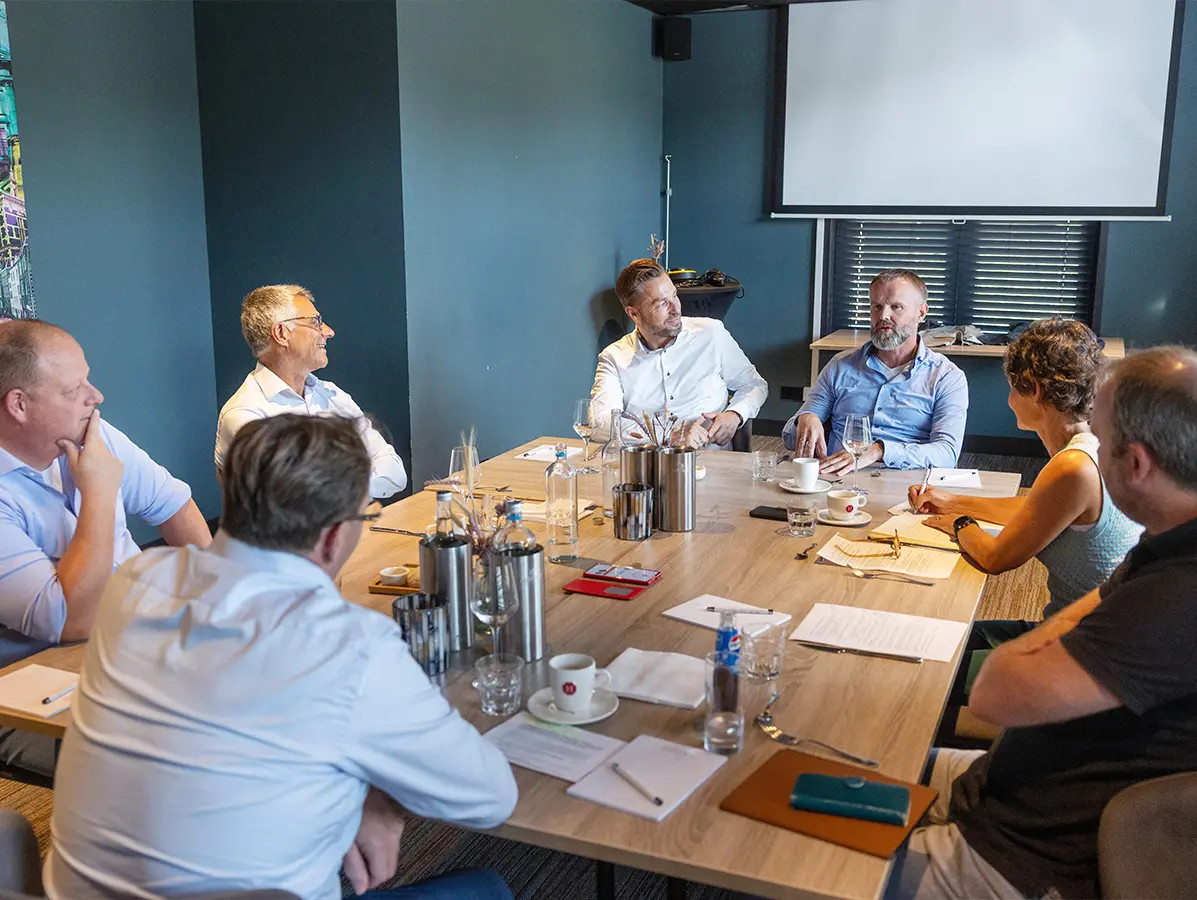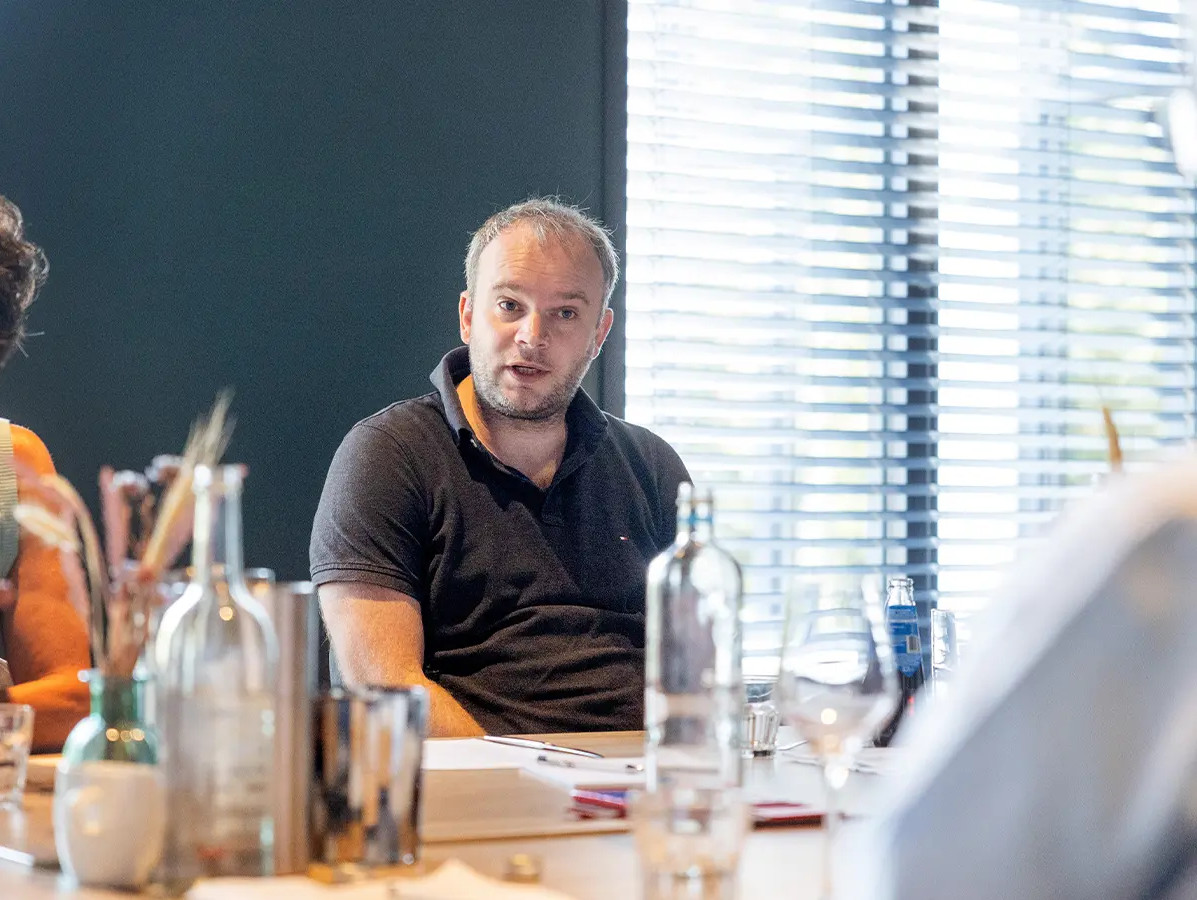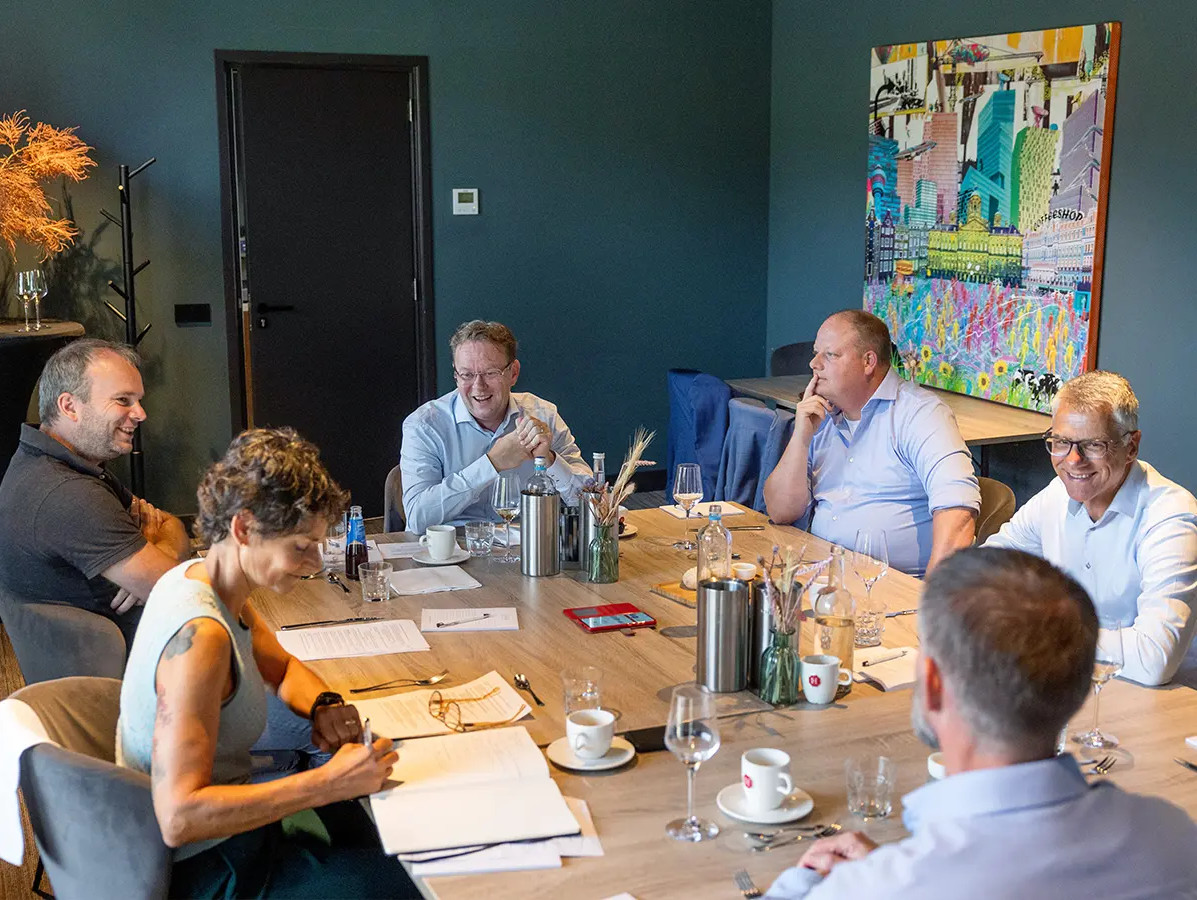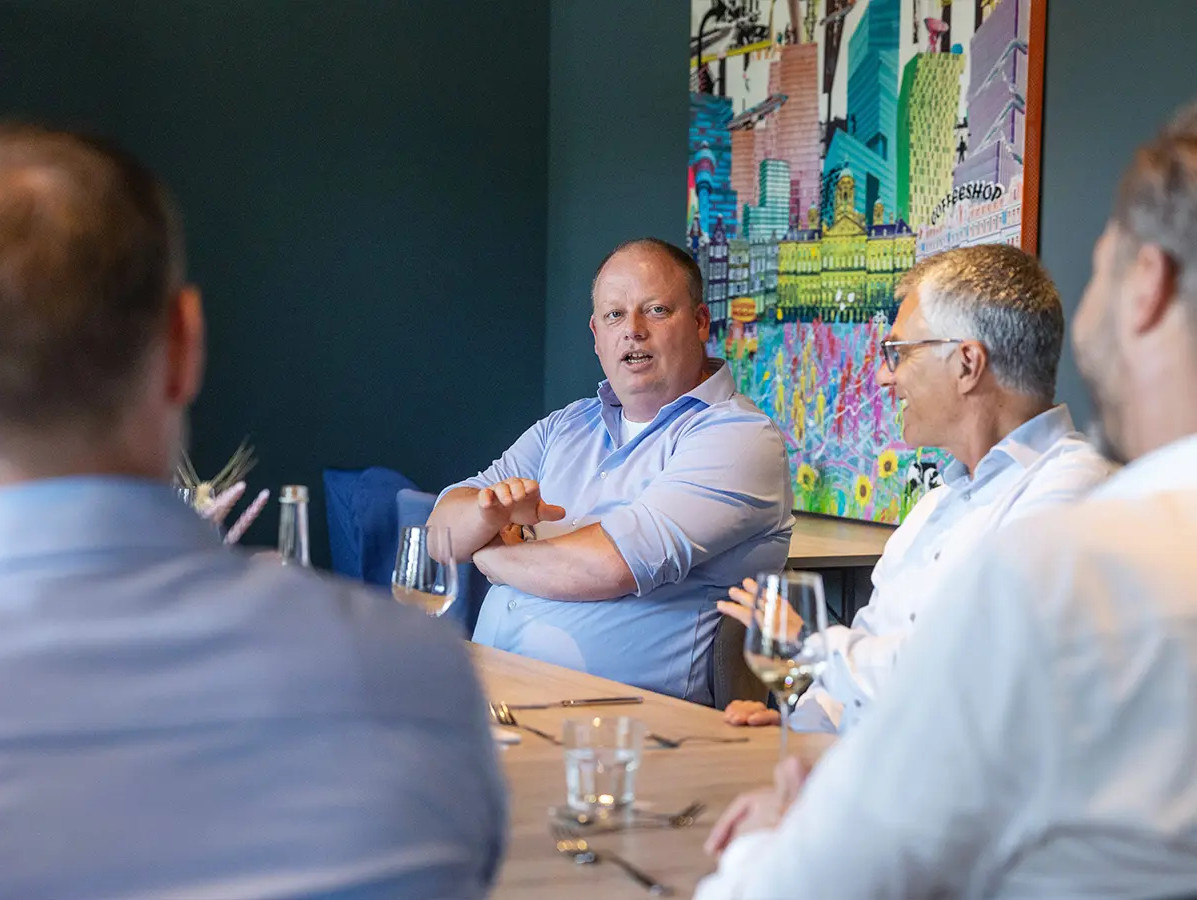
The food industry is facing numerous challenges: shortages of raw materials and resources, rapidly changing consumer trends, and a lack of (skilled) personnel, just to name a few. What role can high-tech solutions, robotics, and digitalization play in achieving more effective, efficient, and sustainable production?
Over a pleasant lunch at Restaurant Zuiver in Leusden, we discussed the current state of affairs, opportunities, and bottlenecks surrounding automation, digitalization, and robotics in the food industry. At the invitation of Ceel Elemans (Sector Banker Food, ING), Seine Ligtenberg (ING Director of Trade & Retail and Food & Agri, Northern and Eastern Netherlands), and Vakblad Voedingsindustrie, the following people joined the discussion: Harm ten Napel, Director of Zalmhuys Group; Diederik Vergeer, Managing Director of Vergeer Holland; Martijn van Dijk, CFO of Hutten Beef; and Onno Lukkien, co-founder and co-owner of DGS.
Automating and robotizing in the food sector isn’t easy. Often, packaging lines are already automated, but at the start of the line, the lack of uniformity throws a wrench in the works. “Every fish is different,” confirms Harm. “They range from 2 to 7 kilos, which makes robotization tricky. Still, it’s possible. The technology has improved and refined significantly over the past few years. We now get more yield out of a whole salmon. Compared to humans, machines are now more efficient and precise, something that wasn’t true a decade ago. In our smokehouse, slicing machines ensure that the slices are exactly the right weight, and a robot places them into a machine where they come out neatly packaged. There used to be much more manual labor involved, like weighing and trimming.”
Martijn adds, “The cattle we slaughter come from dairy farms, and there are significant variations in the age at which they’re offered for slaughter, which impacts their weight. Additionally, the quality of the meat is influenced by many factors: the age, where and how the animal lived, and what kind of feed it was fed. These factors are much less uniform in dairy farms than, for example, in the veal sector. This partly explains why the production hours per cow have increased. The animals are all unique, which means extensive robotization is not yet possible. However, the work has clearly become less physically demanding for our employees over the past ten years. They remain much more upright throughout the entire process, both literally and figuratively. Not only do they have to bend less, but pushing the carcasses into the right position on the platforms is now fully automated—no hands are required anymore. The time spent processing a cow’s carcass was about 3.5 hours in 2015. Now it’s 5 hours, but the yield has increased proportionally. No robots are involved here; it’s all done by humans. A key KPI for us is ensuring the correct selection of meat reaches the right customer at the end of the line. At the moment, that’s entirely a human task. It’s too specialized to automate. AI isn’t ready for that yet, though I do expect we’ll be able to make improvements in the future with the help of vision technology.”

Harm ten Napel
Vergeer Kaas has already made significant strides in this area, as Diederik shares. “Our new facility in Bodegraven, located along the A12, is highly automated with high-speed lines running almost continuously. Ten years ago, we still had twenty internal orders before the final product was ready. Now, everything flows in one go, and hardly any forklifts are used—only for inbound and outbound checks.” This didn’t happen overnight; a lot of development time went into designing a good slicer. “We handle many different types of cheeses, and each cheese is unique. For instance, young cheese has only undergone three rind treatments, while old cheese has been treated up to forty times. The latter has a thicker rind, so it needs to be sliced thicker. Additionally, the cheeses mature at high temperatures but need to be cut at lower temperatures. At the new facility, the cheeses are automatically cooled down, labeled with an article number, and transported to the slicing line. Depending on the article number, the machine automatically slices them thicker or thinner. The rind needs to be removed in one go, with minimal waste. The next step is cutting the cheese—into halves, thirds, blocks, or consumer portions—and finally packaging. Every step is monitored: we can adjust instantly thanks to vision control. Is there a spot on the cheese? Is the seal on the packaging intact? Even the smallest cumin seed in the seal is detected. And just one operator can control the entire line. Thanks to these controls, complaints have significantly decreased, and waste has been greatly reduced. Thirty years ago, we were happy with a 3% failure rate. Now, the minimum standard is 0.1% on average. These are huge leaps, as cheese is an expensive product.”
A key driver behind the need for robotization is the increasing labor shortage. Ceel describes the developments in the labor market as ‘disastrous.’ “The Central Bureau of Statistics (CBS) predicts that in the coming years, 25% of the workforce in the food industry will leave the sector. That’s more than 35 thousand people! Discussing with our clients how they plan to address this challenge is very important to us. As a company, you need to think about how you are going to replace the people who will be leaving in the coming years. What steps are you taking to remain future-proof?”
Both Hutten Beef, Vergeer Holland, and the Zalmhuys Group experience the labor shortage as a major bottleneck. “In particular, attracting skilled personnel is becoming increasingly difficult,” says Martijn.
DGS, however, has less trouble finding technically skilled staff. “We’re fortunate to be a rapidly growing company with many new developments in the technical field,” says Onno. He then addresses the challenge Hutten Beef faces in finding the right skilled workers for deboning: “One solution is to position your people more intelligently and ensure the right skills are applied in the right roles. This can improve the end result while reducing costs. These are processes that DGS carries out in close consultation with the customer. Many factors influence the result.”
“It’s not just about a shortage; we also need a different type of worker,” Diederik adds. “Line workers need to be more technically skilled. To address this, we’ve created our own training program for our operators. The ‘high potentials’ operate the most complex lines. We’d love to employ them directly, but that is where we hit another bottleneck: in addition to a job, housing is essential, a significant portion of our workforce consists of labor migrants. They work through employment agencies, and if we hire them permanently, they lose their homes. With the current housing crisis, we don’t have a solution for that yet. That is where we are hitting the wall now.”
Harm agrees: “It’s recognizable. Where should these homes be built? Everyone knows it’s necessary, and yet they say ‘not in my backyard’. This is a delicate issue. We want to solve it, it needs to be well-organized, but we face all sorts of legal and regulatory challenges in finding good solutions.”
The Advisory Council on Migration (ACVZ), an independent advisory body established by law, also notes that the government needs to step up and develop a new vision on labor migration in its report ‘Balanced Labor Migration. Targeted Labor Migration Policy for Broad Prosperity’ (www.adviesraadmigratie.nl). Excluding sectors is not a workable solution, as the general consensus around the table suggests, but permit requirement for employment agencies is something they could support.

Clockwise from left: Judith Witte, Harm ten Napel, Diederik Vergeer, Onno Lukkien, Ceel Elemans, Martijn van Dijk.
Back to the factory: where are the biggest innovations when it comes to robotization in the food industry?
“The focus of future developments will be on improving camera and vision technology combined with gripper techniques,” observes Onno. “Many companies want to move too fast. You need to approach this step by step. To us, a robot is just a dumb piece of metal that we teach a trick. And that’s where the added value lies. It starts with collecting data: the focus is on being able to observe and then signal what is where. Only then you can ‘teach’ the robot which actions to perform. For example, we’re working on a project for a food company to use vision technology to recognize different products and qualities: what is the front and back, what is left and right? That has to be correct first. Next comes picking up the product and placing it in a fixed position. Picking up with quality recognition, naturally with our own production software for tracking and tracing, can lead to great improvements.”
Harm adds: “We conducted a similar vision pilot with a machine supplier. The goal was to detect spots on the salmon so they could be sorted immediately. So much time and energy from our staff went into it; tremendous! A point of attention here is: who pays for all this renewal and innovation? Automation progresses faster when there’s a large market for it, and when techniques can be used across multiple industries. The market for systems specifically for the fish and salmon industry is actually quite small. Production needs to continue; we can’t just set up a ‘test line.’ We do run pilots, but we can’t afford to reduce our output for an extended period—there’s simply no margin for that. We prefer a fully developed technology in the line. That’s not possible, we are fully aware of that. The truth is, unfortunately, that if we develop something only for ourselves, it becomes very expensive. If we do it together with the machine supplier, competitors can benefit from our investment. We put a lot of time and effort into the project, and then a competitor can simply ask for the same machine we have at Zalmhuys. It’s a tough dilemma.”
The three food producers recognize the problem. They nod in agreement.
Diederik shares, “Although we have a lot of in-house knowledge, we really need the machine builder when developing new technologies. For the input inspection of cheeses, we once had to provide 600 photos of everything that wasn’t right. That took a lot of time. We paid the development costs ourselves but made good agreements with our supplier. For every machine equipped with this AI tool that they sell, we get a fixed amount.”
Onno adds, “At the food company I mentioned earlier, we put this issue openly on the table: ‘These are the development costs. How do we divide them?’ It took us less than 10 minutes to come to an agreement. Despite the diversity in the food industry, the processes are often similar, and if we can apply our knowledge across multiple areas, it lowers the costs for the customer. The principle is that our customers are experts in their own processes and products. They can expect us to have the ability to think along with them and offer the creativity to improve the process together. In the future, integrating data into processes will become even more important, and we’re investing in that as well. A good partnership between us and the food producer is essential: both companies invest time and money in innovations. This gives both parties a head start. Shoulder to shoulder, we look to the future. Partnership and trust are the foundation.”

Are the high investment costs a barrier for food companies to automate and robotize?
“No, I don’t think so,” says Seine. “Food companies in the Netherlands are in fact very aware and actively working on robotization. If the payback period is well-calculated and fits with the standards we have in mind, we fully support the continued development of a company so that it remains at the forefront. We give them the space to do so. In our conversations with customers, we continuously discuss questions like: ‘What is your position in the market? What is your reason for existing, both now and in the future? What are the opportunities and threats?’ It starts with a solid financial analysis. Production efficiency and scaling up are crucial for survival. Labor shortages are a threat to that. You must be efficient. If you don’t keep up now, you’ll be too late.”
Ceel adds, “With major investments, so-called leap investments, companies tend to have a very optimistic outlook on the future. That’s fine, but we also want to see a worst-case scenario. As a company, you have to think about the question, ‘What if everything goes wrong?’”
“For us, things went well,” Martijn laughs. “We’ve grown much faster than we predicted over the past ten years, which raised a lot of new questions. In 2015, the then-new building was the first industrial facility in the Netherlands to be BREEAM Excellent certified. Two years later, we already knew we had to expand, particularly in terms of cooling capacity. For this current expansion, we also wanted BREEAM certification, but the biggest challenge was how to keep the existing logistics process, which is incredibly efficient, running smoothly with the new building. We spent six years designing to make that happen.”
Seine notes, “We do see a big difference between family-owned businesses and private equity when it comes to investment and payback periods. Private equity focuses on a maximum payback period of 3 to 4 years, whereas family businesses often think a generation ahead. We’re particularly enthusiastic about family businesses. Research shows that they tend to be more profitable in the long run.”
Martijn agrees, “The fourth generation now at the helm wants to make it clear that we’re here for the long term within our sector. An additional advantage is that obtaining a BREEAM certificate has a positive impact on the investments that need to be made. It opens up subsidy opportunities. But we’re looking even wider; the heat and energy generated from the cooling system will be recovered and used even more than we already do for disinfection and cleaning. That will yield energy savings in the long term, and we’ll be able to control our climate system better.”
To make the investment more manageable for the customer, Onno advises looking a few years ahead. “We focus on the question, ‘How can we improve the beating heart of the factory?’ From there, we create a multi-year plan: how do we realize it, what steps are needed? If you want to develop and implement a full line, as a supplier, you need to be able to build and deliver it in phases,” he believes.
Diederik adds, “The aim of our digitalization and automation efforts in Bodegraven was to improve safety for our people, particularly preventing accidents with forklifts. All the machines are well shielded, and there are no more forklifts—only small shuttle vehicles. But just as important was making an efficiency leap. Those who want to move forward must invest.”
There’s still plenty of discussion after lunch: political issues, local government policies, the working methods of the NVWA, and expansion plans—everything is discussed. But as dessert is served, a unanimous conclusion emerges: a beautiful factory with ingenious robots and advanced digitalization: it’s amazing. And they’re incredibly proud of their businesses. But what does truly make them happy? It’s their team and the dedication of their people. “Working together on a process of continuous improvement; achieving success together—that’s the best thing there is,” Harm concludes. The others at the table can only agree.
Photos: © Herbert Wiggerman
Source: Vakblad Voedingsindustrie 2024